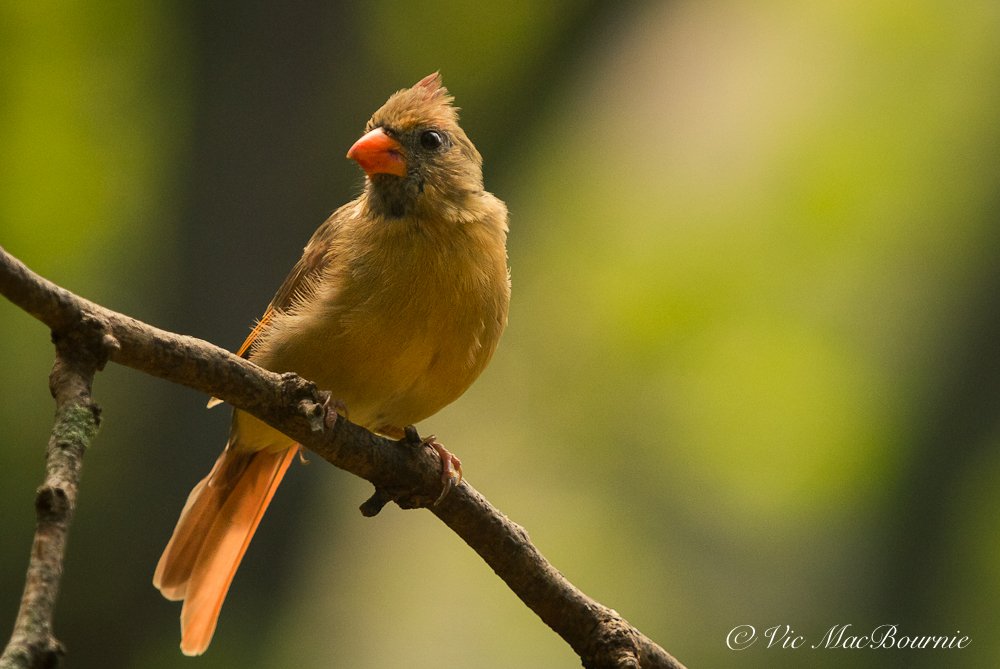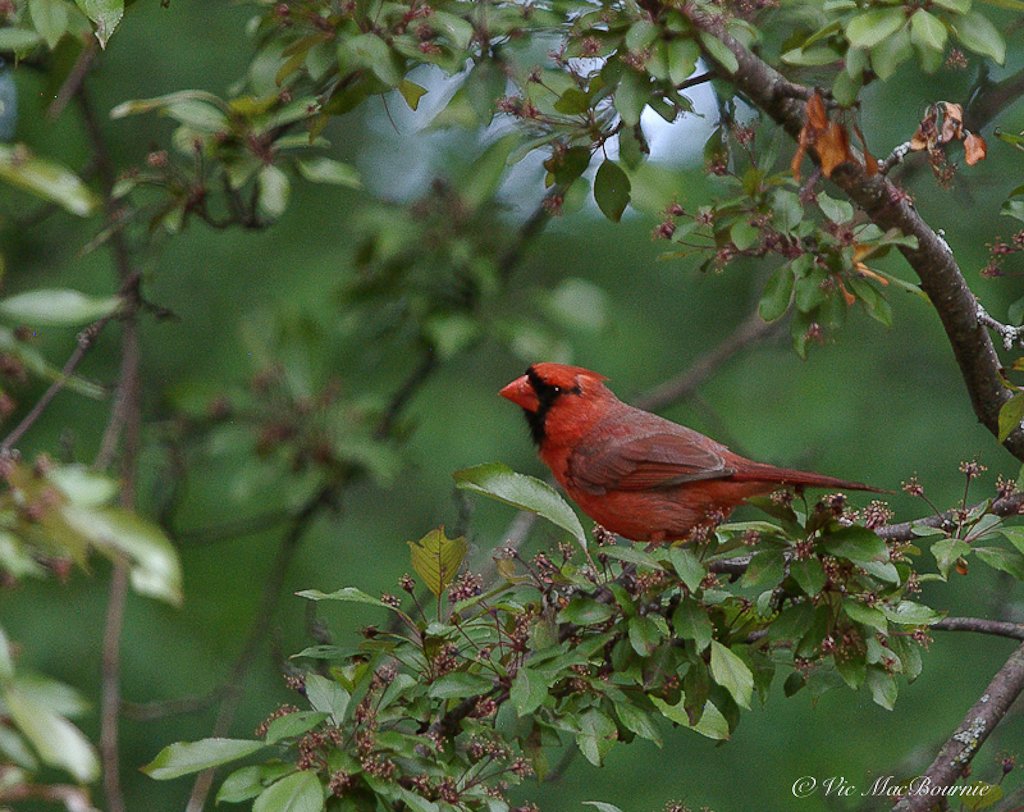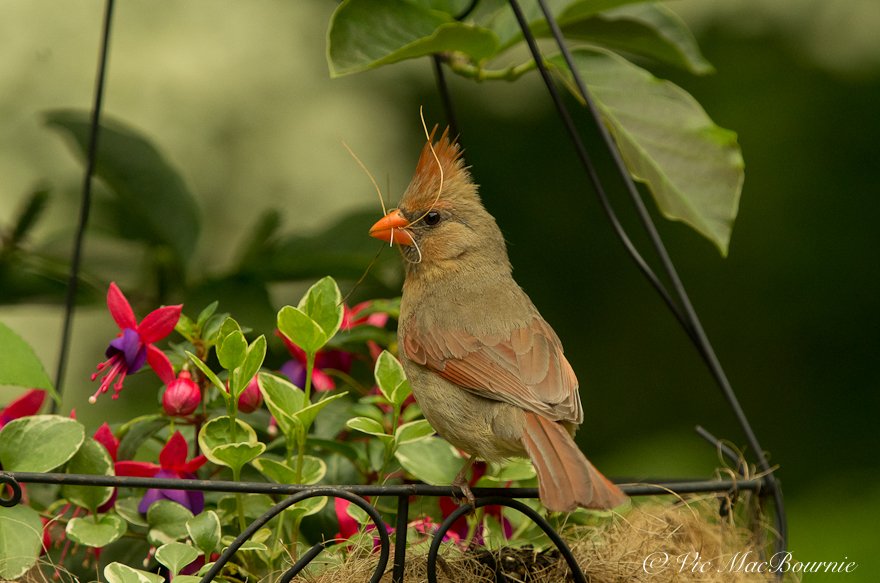Tips to attract Cardinals to your gardens
Why Cardinals are special and why we want them in our garden
It’s difficult to imagine a more sought after bird in our gardens than Cardinals. It really doesn’t matter if it is the vibrant male in his bright red coat of feathers or the equally gorgeous female in her beautifully buff attire.
Both are welcome in our garden and I’m sure every garden where they can be found throughout the United States and parts of Canada. They are native to North America and are a common sight in gardens, parks, and woodlands, as well as suburban areas.
Cardinals prefer habitats with dense shrubs and trees, such as forests and thickets, where they can find cover and protection. An open woodland garden is perfect for these omnivorous birds that are as happy eating sunflowers at our bird feeders as they are foraging for insects or hitting the nearest serviceberry bush when it’s in fruit.
While Cardinals are generally non-migratory birds, their behavior can vary depending on their location.
In the northern parts of their range, Cardinals may migrate short distances to find food and shelter during the colder months. However, in more temperate regions, Cardinals tend to stay in their breeding territories year-round.
During the breeding season, Cardinals establish territories and defend them fiercely against intruders. So, it you see a particularly aggressive cardinal pair, chances are they have young nearby.
Check out this post for more on Attracting Colorful Birds to your garden.
Why are Cardinals so special to have in the garden?
They are considered special because of their beauty and unique characteristics.
Not only do Cardinals have a melodious song that adds a delightful ambiance to any garden, their mere presence bring joy and a sense of tranquility to outdoor spaces.
There are several reasons why we would want to attract Cardinals to our garden.
Firstly, Cardinals, not unlike most birds, are beneficial for pest control as they feed on insects and pests that can damage plants.
Secondly, they are excellent pollinators, helping to spread pollen from one flower to another, which promotes plant growth and reproduction.
Additionally, Cardinals are territorial birds, and having them in the garden can deter other unwanted birds or animals.
By creating an inviting environment for Cardinals, we can enjoy their beauty and benefit from their ecological contributions.
Providing food sources such as bird feeders with their favorite seeds, as well as planting trees and shrubs that offer shelter and nesting sites, will go a long way to attract Cardinals to our gardens.
Check out my comprehensive post on the Best Bird Feed Choices for Backyard Birds.
What are Cardinals’ favourite plants and trees?
To attract Cardinals to your garden, consider incorporating their favorite plants and trees.
One of the favorite plants of Cardinals is the Eastern Redbud (Cercis canadensis). This tree produces beautiful pink or purple flowers in the spring, which attract Cardinals in search of insects to feed their young.
Cardinals also love Blackberry stands (Rubus spp.). The berries of this plant provide a delicious food source for Cardinals, and the thorny branches offer them protection from predators.
Cardinals are also fond of the American Holly (Ilex opaca). This evergreen tree provides year-round shelter and its bright red berries are a favorite food source for Cardinals during the winter months.
Additionally, Cardinals are attracted to one of our favourite native understory trees, the Flowering Dogwood (Cornus florida). The clusters of white or pink flowers on this tree attract insects, which in turn attract Cardinals. Later the berries of the Flowering Dogwood provide an excellent food source to Cardinals and other fruit eating birds and mammlas.
In addition to these plants, Cardinals are also attracted to gardens with a variety of shrubs such as the Red Osier Dogwood (Cornus sericea) and the Spicebush (Lindera benzoin). These shrubs provide dense cover and berries that Cardinals find appealing.
By incorporating these favorite plants and trees into your garden, you can create an inviting habitat that will attract Cardinals. Providing a diverse range of food sources and shelter options will increase the likelihood of Cardinals not only visiting your garden but setting up a nest and raising their young.
What are Cardinals favourite seeds and the bird feeder?
Cardinals have specific preferences when it comes to seeds and bird feeders.
To attract these beautiful birds to your garden, it’s important to provide them with their favorite seeds and a suitable bird feeder.
One of the favorite seeds of Cardinals is the black oil sunflower seed. These seeds have a high oil content, which provides the Cardinals with the energy they need throughout the year, but especially in the winter when other food sources are more scarce.
Cardinals also enjoy eating safflower seeds, which have a bitter taste that squirrels and other birds tend to avoid. By offering safflower seeds, you can attract Cardinals while deterring unwanted visitors.
At our feeding station, I try to offer safflower in a separate, larger feeder that Cardinals can easily access.
When it comes to bird feeders, Cardinals prefer platform or tray feeders. These feeders have a flat surface that allows Cardinals to easily perch and access the seeds. It’s important to choose a feeder with a large enough platform to accommodate the Cardinals’ size.
To further attract Cardinals, consider placing the bird feeder near shrubs or trees that provide cover and protection. Cardinals. like most birds, prefer to have nearby perches where they can retreat to if they feel threatened.
By providing Cardinals with their favorite seeds and a suitable bird feeder, you can create an inviting environment that will attract these stunning birds to your garden.
Remember to regularly clean and refill the feeder to ensure a steady food supply for the Cardinals throughout the year.
Why do I hear Cardinals singing so early in the spring?
The male cardinals begin calling out for a mate at the first signs of spring in our garden. They are known for their beautiful songs, which they use to communicate and attract mates. Cardinals are monogamous birds and form strong pair bonds that can last for several years.
In the winter, Cardinals often gather in flocks, which can include both males and females. These flocks provide safety in numbers and help Cardinals find food more easily.
They are particularly attracted to areas with abundant food sources, such as bird feeders stocked with their favorite seeds.
Why are some cardinals bald in the summer?
During the summer months, you may notice that some cardinals appear to be bald or have patches of missing feathers.
This phenomenon is known as “cardinal molting,” and it is a natural process that occurs in many bird species.
Molting is the process of shedding old feathers and growing new ones. It is essential for birds to maintain their feathers in optimal condition for flight, insulation, and protection. Cardinals, like other birds such as Blue Jays, molt their feathers once or twice a year, typically in the late summer or early fall.
For more on bald birds and molting, check out my earlier post here.
The reason why some cardinals may appear bald during the molting process is that they shed their feathers in a specific pattern. Feathers are not shed all at once but rather in a sequential manner. As a result, cardinals may have areas of exposed skin or patches of missing feathers during the molting period.
It’s important to note that cardinal molting is a temporary condition, and the missing feathers will eventually be replaced with new ones. During this time, cardinals may appear less vibrant and colorful than usual, but once their new feathers grow in, they will regain their striking appearance.
To support cardinals during the molting process, provide them with a balanced diet rich in protein, such as mealworms or suet. These food sources can help promote healthy feather growth and ensure that cardinals have the necessary nutrients to thrive.
Understanding why some cardinals are bald in the summer can help you appreciate the natural processes that birds go through to maintain their plumage. By providing a welcoming environment and nutritious food, you can support cardinals during this important stage of their life cycle.
Where do cardinals create their nests?
Cardinals are also known as skilled nest builders. They prefer to build their nests in dense shrubs and trees, providing them with protection and privacy.
One common location where cardinals create their nests is in the branches of evergreen trees, such as pine or spruce trees. The dense foliage of these trees offers excellent coverage and helps to conceal the nest from predators.
In our garden, cardinals are regulars in our neighbour’s large spruce trees that run down the side of our property and provide year round habitat for Cardinals and other backyard birds.
Another favored nesting spot for cardinals is in thick shrubs or bushes, such as holly or azalea bushes. These plants provide ample coverage and protection, making them ideal nesting sites for cardinals.
The female cardinal takes the lead in nest construction, using twigs, grass, leaves, and other plant materials to create a sturdy and well-hidden nest.
Providing a variety of vegetation in your garden can attract cardinals and encourage them to build their nests nearby.
Additionally, having a water source, such as a birdbath or fountain, can further entice cardinals to choose your garden as their nesting site. By understanding where cardinals create their nests, you can create a welcoming environment in your garden.
Offering suitable vegetation and a water source can increase the chances of cardinals choosing your garden as their nesting site, allowing you to enjoy their presence and observe their nesting behaviors up close.
How many babies do Cardinals usually have in one year?
Cardinals can also be prolific breeders. In a single breeding season, a pair of cardinals can produce multiple broods, resulting in a significant number of babies. The breeding season for cardinals typically begins in early spring and extends into mid-summer.
During this time, the female cardinal will lay a clutch of eggs, usually ranging from 2 to 5 eggs. Incubation lasts for about 11 to 13 days, with both the male and female taking turns to keep the eggs warm. Once the eggs hatch, the parents work together to feed and care for the nestlings.
Cardinals are diligent parents, providing a steady supply of insects, seeds, and fruits to their hungry offspring. The nestlings grow rapidly, and within 9 to 11 days, they are ready to leave the nest.
After the first brood fledges, the female cardinal may lay another clutch of eggs and repeat the breeding process. This can result in multiple broods throughout the breeding season, with each brood consisting of 2 to 5 nestlings.
Overall, cardinals can have anywhere from 2 to 4 broods in a single breeding season, depending on factors such as food availability and nesting success. This high reproductive rate ensures the continued population growth of these beloved backyard birds.
Are Cardinals in danger of going extinct?
Cardinals are not currently in danger of going extinct.
In fact, they are one of the most abundant and widespread bird species in North America. Their population has remained stable over the years, thanks to their adaptability and ability to thrive in a variety of habitats. One of the reasons why Cardinals are not at risk of extinction is their ability to adapt to different environments.
They can be found in a range of habitats, including forests, woodlands, gardens, and urban areas. This adaptability allows them to find food and shelter in various settings, ensuring their survival.
Another factor that contributes to the Cardinals’ population stability is their generalist diet. Cardinals are omnivorous birds, meaning they eat a wide variety of foods, including seeds, fruits, insects, and even small vertebrates.
This flexibility in their diet allows them to find food sources even in changing environments.
Furthermore, Cardinals are not heavily impacted by human activities. Unlike some bird species that are affected by habitat loss or pollution, Cardinals can coexist with humans and even benefit from human-made landscapes, such as gardens and parks.
While Cardinals may face localized threats, such as predation or severe weather events, their overall population remains healthy and stable.
By continuing to provide suitable habitats and food sources, we can ensure that Cardinals continue to thrive and bring joy to our gardens for years to come.
Author Profile: Vic MacBournie is a former journalist and author/owner of Ferns & Feathers. He writes about his woodland wildlife garden that he has created over the past 25 years and shares his photography with readers.








